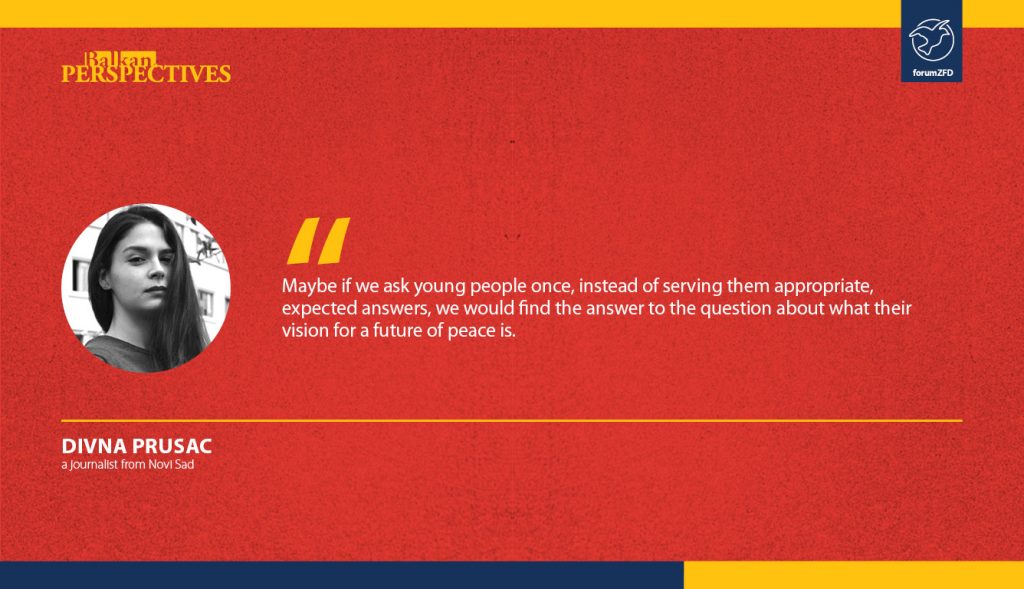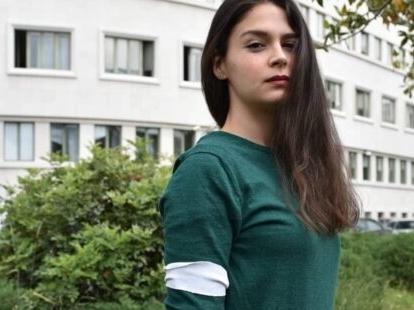The process of transitional justice and dealing with the past has been going on for over twenty-six years. However, it seems that credible information about the war, and about the process of reconciliation between the countries in the region is not available to young people in Serbia. The Balkan Perspectives interviewees agree that institutions bear great responsibility, along with the media, which is mostly biased and on the side of the dominant state narrative when reporting on these topics.
Jelena Božić is a young journalist. Dealing with the past has often featured as a key topic in her work. She says that her professional interest in the process of transitional justice began to grow when she realized that people in her surroundings had feelings of anger, worry, fear, and even hatred – feeling that she could not understand.
“That was the moment when I realized that if we, who are alive right now, and who wish to have a peaceful co-existence, don’t do anything about solving the conflict and dealing with the past, then nobody will do it. I realized that it is impossible to change the past, but that we can and must change the future. For that to happen, we must first deal with the past,” emphasizes Božić adding that schools do not teach children about the war history, and especially not about the process of reconciliation.
Sociologist Miloš Perović thinks that the dominant narrative when it comes to dealing with the past in Serbia is that the Serbian society does not need to deal with the past.
“The dominant narrative when it comes to dealing with the past in Serbia (if by that we mean dealing with the crimes committed in the name of the ‘Serbian nation’ and to ‘defend the Serbian people’ in the wars in former Yugoslavia) is that dealing with the past isn’t necessary. Serbia, except for a short while in the first decade of this century, has completely ignored the question of its own responsibility for the destruction during the war in former Yugoslavia,” states Miloš Perović.

Despite the extensive archives of the International Criminal Tribunal for the former Yugoslavia, which contain evidence and facts about the war in Yugoslavia, history textbooks in Serbia and in other countries in the region are not in line with the facts established by the Tribunal. Instead, history textbooks seem to mirror the dominant narratives of the societies in the region teaching children and youth falsehoods about the past of their countries.
The editor-in-chief of the portal Fejk njuz tragač (Fake News Seeker), Stefan Janjić, believes that the information related to the ‘90s available in the Serbian media is “extremely emotional and biased, distributed with no particular effort to better understand the past.”
“Discussions come down to several painful issues, several war crimes and war criminals, and even then, there is no honest desire to at least shed light on those fragments, instead the process of interpreting history takes place – in the words of Hrvoje Klasić – just like in a supermarket, where we selectively choose the information which are in favour of, proving our desired theory,” says Janjić.
Miloš Perović says that there are no precise data when it comes to the availability of information about dealing with the past for young people, but that it seems that the availability of that information is not beneficial for the regime in Serbia.
“I am certain that it is not in the interest of the current regime in Serbia to make credible facts about these events more accessible because the current regime is made up of those who are responsible for the war, both in an ideological and personal sense,” said Perović.
The project “Digital Natives Combating Dangerous Narratives in the Region” of the Independent Association of Journalists of Vojvodina and the Forgotten Children of War Association was aimed to encourage the exchange of information and cooperation between young journalists from Serbia and young activists from Bosnia and Herzegovina, who worked together to create media content about the process of dealing with the past and reconciliation in the region.
One of the project coordinators, Nataša Ivaneža, says there is hope that the generation of youth who grew up using the Internet is much more willing to search for new facts, and to question those already given, in spite of the existing indoctrination.
“What I think is very good and optimistic is that even if they are in some way indoctrinated by certain narratives, they are willing to listen to the other side; they are ready to question their beliefs and deep-rooted opinions. Of course, I speak from my experience of working only with certain groups of young people, so the question is what is it like for young people who do not have the opportunity to hear the other side and whose sources of information are primarily school and some mainstream media,” explaines Ivaneža.
Jelena Božić says that young journalists who deal with these topics all share the same desire for social change and have empathy. Still, in her opinion, young journalists often give up on these topics because they often come with a safety risk.
Just as a reminder, hate graffiti appeared in late 2020 on the building where journalist Dinko Gruhonjić lives. He dedicated a great part of his journalist career to transitional justice and opposing nationalist narratives. Therefore, that was a clear sign that those whose work is dedicated to dealing with the wartime past of the ‘90s are not welcome in the public discourse of the Serbian society.
“I think the problem is that working with these topics always carries a risk. There will always be someone who will say that you are on one side or the other, that you are a traitor, and we have witnessed many attacks on journalists who have been working with these issues, so young journalists often avoid the topic of dealing with the past. I am sure that, if systems that really worry about the safety of journalists actually existed, and if more attention was given to this topic during education, more young journalists would be interested. Simply put – if they didn’t have to think about being beaten up or dragged off into some dark corner, because they wrote that Ratko Mladić is a criminal, not a hero, for example,” says Jelena Božić.
Nataša Ivaneža emphasizes that it is necessary to enable youth to visit places that are crucial for understanding the history of our peoples, but also to give them support to process everything they learn more easily.
“What turned out to be important for us was to have a therapy session with our young participants after visiting the Memorial Center. They were given a safe space to express their feelings and thoughts about what they had experienced there, which meant a lot both to them personally and to the whole group, because it connected them on a deeper level,” says Ivaneža adding that many of them continued to pursue the topic of dealing with the past, either through their journalist work or through some other kind of social engagement.
Stefan Janjić thinks that audiences react to testimonies better than to summarized facts, so creating such content could be more appealing to the public.
“If the focus of the content is, for example, an estimated number of women raped during the war, many will express doubts in the accuracy of that data, or they will react with a cynical emoji, or they might leave an offensive comment. However, if you have in front of you a testimony of a woman who survived violence, the perspective changes: you are no longer looking at statistics, but at someone’s actual pain,” explaines Janjić adding that “such an approach requires a lot of bravery from survivors to appear in public and tell their story, with the awareness that there will be dozens of unemphatic and mean comments under that video or article.”
Jelena Božić says there is a lack of content that would explain to youth why this topic concerns them too. She emphasizes that “adjusting the content for a young audience does not mean making content more banal, but accommodating the topic to the context in which young people currently live.”
“It is important to explain to young people how the past influences the moment we are at now. It is important to express it in a way that it is understandable to young people, using formats that young people follow. It is always good that when we want to reach a younger audience, we include them, encourage them to think and reconsider their views, but it is also crucial that we do not underestimate them, “, concludes Božić while speaking for Balkan Perspectives.
The media, civil society, institutions, and the shadows of all those who did not succeed in the endeavours of reconciliation, without hesitation now leave the burden of the past to the youth, because “the young are the future”. So, it might be time for all those who ponder, evaluate, and analyse the past to raise the question: what should we do to stop it? It is time to actually ask the young people: how do we move forward from this rut we have been stuck in for almost thirty years?
Maybe if we ask young people once, instead of serving them appropriate, expected answers, we would find the answer to the question about what their vision for a future of peace is. Young people want to hear the story of Sarajevo, the city whose boulevards were shelled and whose citizens have the warmest smiles. They want to hear about Srebrenica and Prijedor, the silent cities still standing as witnesses to human dishonour. They want to know about the past of the countries that once stood united. One day, these young people will proudly say they live in peace, a peace that we imagined for decades. So let them participate in the process of reconciliation that You now direct, because they will be the ones to inherit it. Ask young people how they want to hear about the past, because they will continue to deal with it.
Divna Prusac is currently studying on the European Regional Master’s Program in Democracy and Human Rights in Southeast Europe. After that she aspires to pursue a career in peacebuilding, since she strongly believes reconciliation and dealing with the past are of utmost importance for the process of democratization in the region. In addition to her BA in Preschool Teaching, she also holds a BA in Journalism and has been working as a journalist for three years. Her journalistic work is mostly focused on issues concerning transitional justice and dealing with the past in the Western Balkans region with a special emphasis on reporting on the rights of women who endured sexual violence during the Yugoslav war.




